Central Mexico – Go With Adventures Abroad
Alison and I have just returned from the inaugural Adventures Abroad tour of Central Mexico with veteran tour guide Victor Romagnoli, featuring the Day of the Dead festivities. All I can say is that it was eye-opening in every sense of the word and although I’ve travelled enough to know that one’s impressions of a country before ever being there are seldom accurate, this was never so apparent as on this trip. Although we had been to Mexico previously we were limited to the Yucatan, while this Central Mexico trip was primarily centred around Mexico City and the great colonial cities that surround it in the Central Mexican Highlands. It is the heartland of the country and home to many of the greatest archaeological sites as well as the places where almost all of the most important events in Mexico’s War of Independence took place. Here are my nine reasons that you should seriously think about booking this trip in 2019.
1. Central Mexico is Safe
Probably the biggest misconception Americans and Canadians have about Mexico is that it is not a safe country in which to travel. Every murder of a tourist seems to receive world wide publicity and yet tourists are the victims of crime every day in countless other destinations, including most notably United States. Yes, Mexico has a horrendous murder rate, but it is overwhelmingly connected to the drug trade and centred near the American border or in coastal cities. Read this article by Lonely Planets U.S. Travel Editor Robert Reid and you might be surprised to find that statistically, Americans are safer in Mexico than in Texas and particularly Houston. When former Pennsylvania Senator Rick Santorum blasted President Obama for letting his daughter Malia vacation in the city of Oaxaca, he obviously did not know that Oaxaca has a lower murder rate than his home state. The reality is that Adventures Abroad has been around for decades successfully taking people around the world to many places armchair travellers would consider ‘unsafe’. On this trip we never once felt remotely uneasy or in potential danger. The Mexican people were friendly, welcoming and one could even say at times, deferential.
While this may not happen on future trips, we actually drove past a portion of President Trump’s infamous ‘caravan’ that he decried as such a danger to the United States. They were walking alongside the PanAm Highway just outside Puebla and spread out over many miles. While the majority were young men, there were plenty of women and children as well including many obvious three generational families. Rather than fear them, the Mexicans stopped to offer rides and charities and church groups provided them with food and shelter.
I took this picture from the bus as we sped by so it’s not the clearest, but really, this group is a menace to America? The real menace lives on Pennsylvania Avenue.
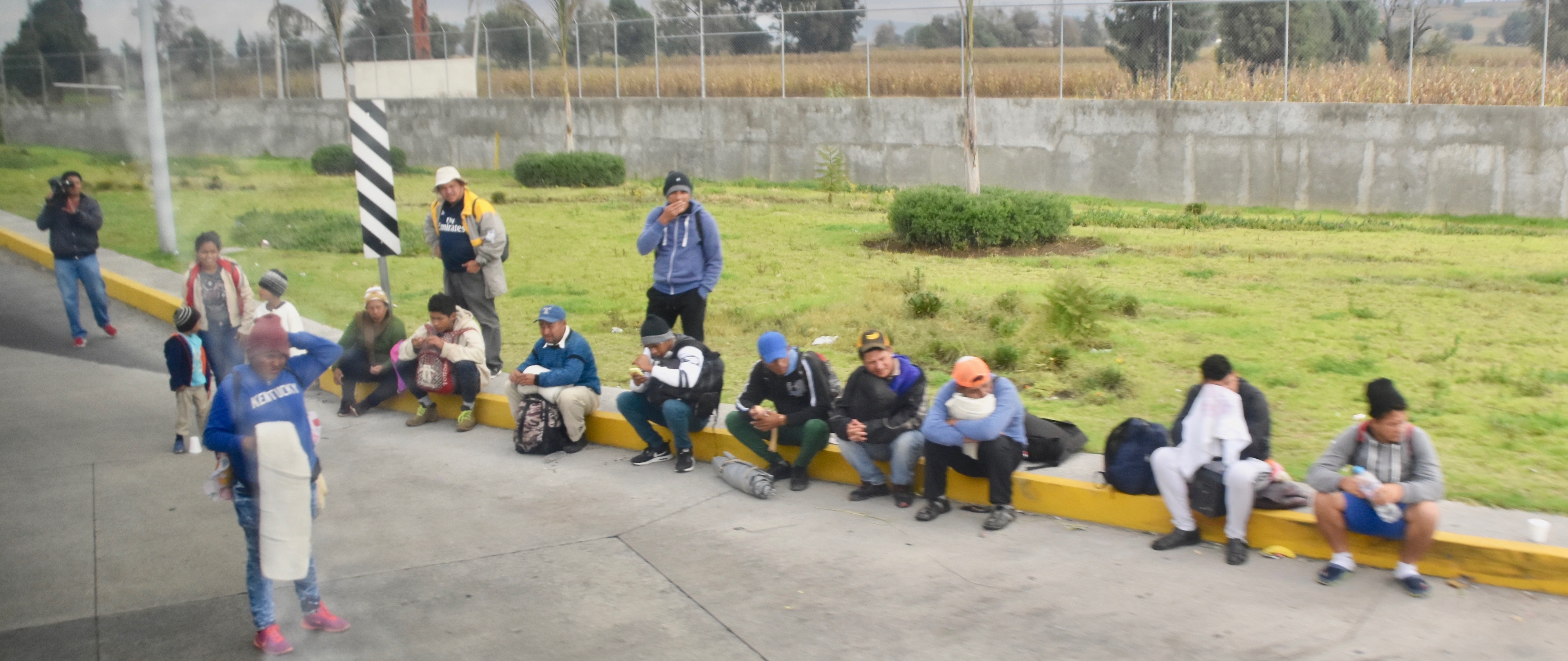
One final point on safety – the Mexican road system in Central Mexico is excellent and the drivers are not lunatics. I felt far safer driving around Mexico and walking the streets of its cities than I ever did in Greece where the drivers are certifiably insane.
So you can put away the number one excuse for not visiting Mexico, or at least Central Mexico. It’s safe.
2. You Won’t Get Montezuma’s Revenge
The second most popular excuse for avoiding Mexico is that people think they are likely to get food poisoning or Montezuma’s revenge as it was once satirically called. Aside from the fact that the proper spelling is actually Moctezuma, on this tour of Central Mexico you will be introduced to a great variety of regional cuisines, mostly in well run clean restaurants. There will also be the opportunity to try some street food if you are more daring, like me.
This is a nopal taco made from the leaves or pads of what we refer to as the prickly pear cactus. It may have been the best tasting snack I had on the trip.
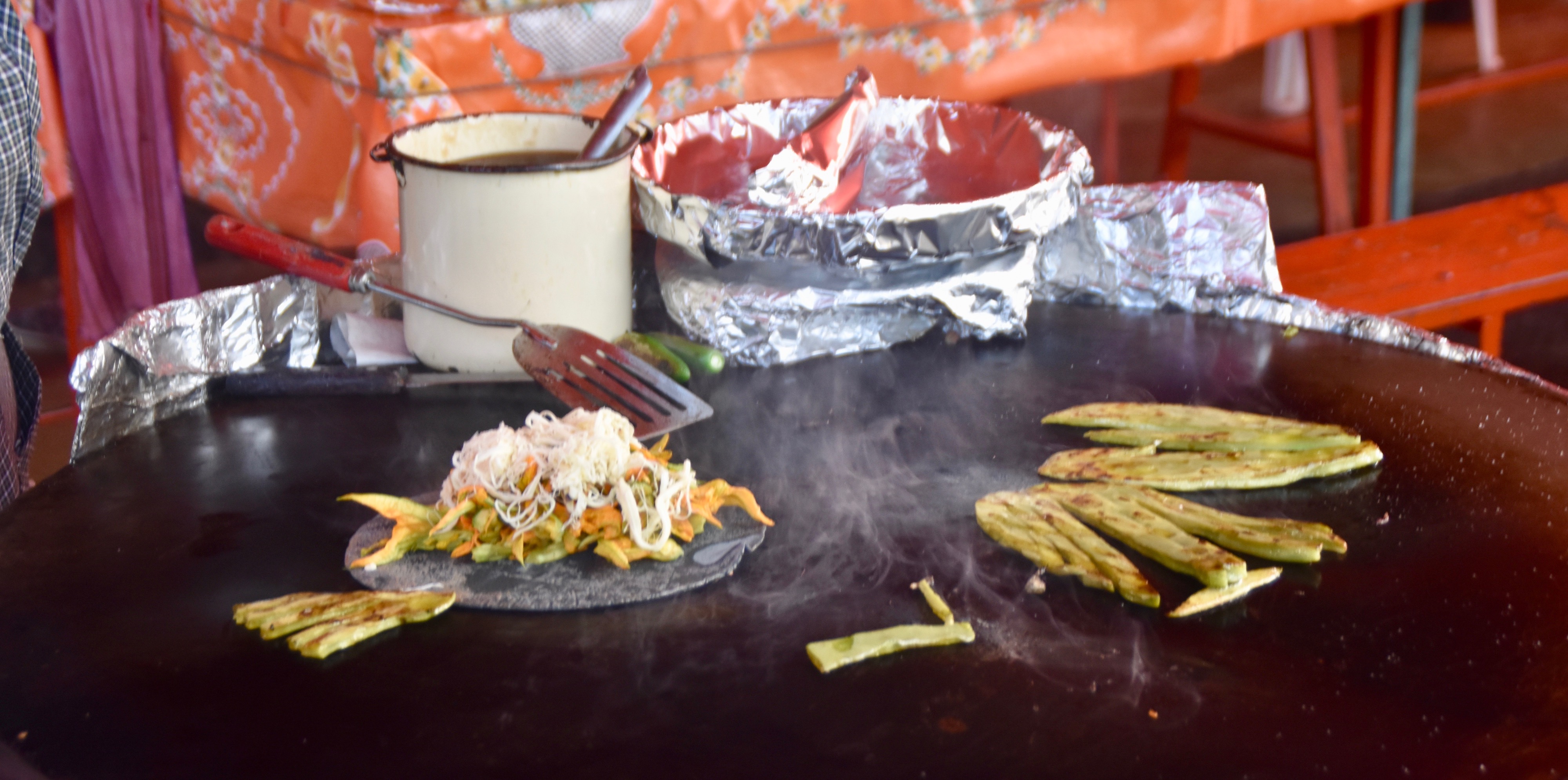
In fairness, to be on the safe side we did drink only bottled water and avoided, to some degree, but not completely, uncooked fruits and vegetables. Not a single person to my knowledge got sick on this tour, although one unfortunate member did get sick when he went on a food tour before joining us, so it does still happen, but if you are careful it shouldn’t.
Now for the positives reasons for going.
3. Victor Romagnoli
Victor has been leading tours for Adventures Abroad for something like twenty-seven years. We first travelled with him to Italy almost twenty years ago and he has developed a legion of loyal followers who have been on many trips with him. The reasons are quite simple. Firstly, Victor is a true polymath. His knowledge of and fluency in languages is unequalled by any guide I have ever travelled with. This language proficiency is equalled by his amazing knowledge of history, archaeology and natural history. One might expect a local guide to know every plant, bird or mammal you might encounter, but Victor guides on six continents and dozens of countries. I was continually amazed by the depth of his knowledge about all things Mexican, often more so than the local guides we used at specific locations.
Secondly, Victor is an incredibly good shepherd of people. He has the patience of Job and doesn’t get flustered or frustrated by the things that often pop up unexpectedly on tours like this. Unlike many guides, he is very flexible and will change the itinerary in a heartbeat if something better comes along. As an example, we were all seated for dinner in Morelia when Victor noted that there was ceremony taking place outside that was attracting a lot of people. We all got up and marched out to see the annual lighting of the Morelia cathedral which is accompanied by great fanfare and music. It didn’t take long, but it was something I would not want to have missed.
Thirdly, Victor will make sure you eat and drink very well on the tour. His knowledge of local cuisines, regional specialties and various types of alcohol you will never find back home is just as encyclopedic as knowledge of history etc. For many meals Victor would order for the table and other times when ordering from the menu he would offer suggestions. Many Central Mexico restaurants do not have English menus so Victor’s translatory skills were always welcome.
In his own orderly hand Victor drew up two sheets which he handed out to everyone. The first was a Pre-Columbian timeline from 60,000 B.C. to the arrival of Cortes in 1521 and the second was a roughly concurrent timeline of what was happening in the rest of the world. I’m looking at these now as I write this and even though I did my preparation for this tour, these simple tools were a great help in putting things in relative perspective.
In a nutshell, travelling with Victor Romagnoli is a pleasure. Here he is acting as first mate and clearing our way through a seemingly impossible boat jam in Xochimilco.
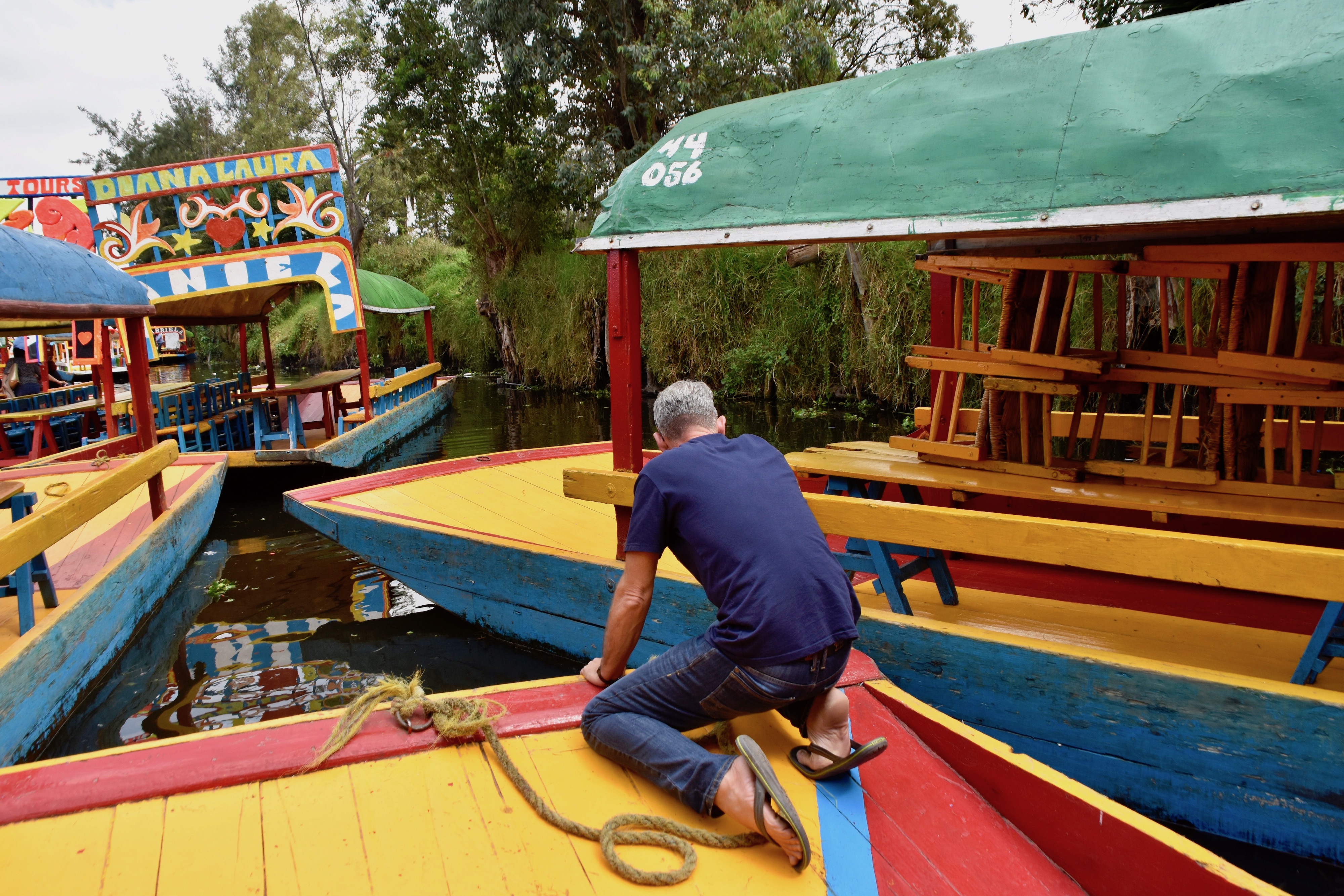
4. The Varying Landscapes of Central Mexico
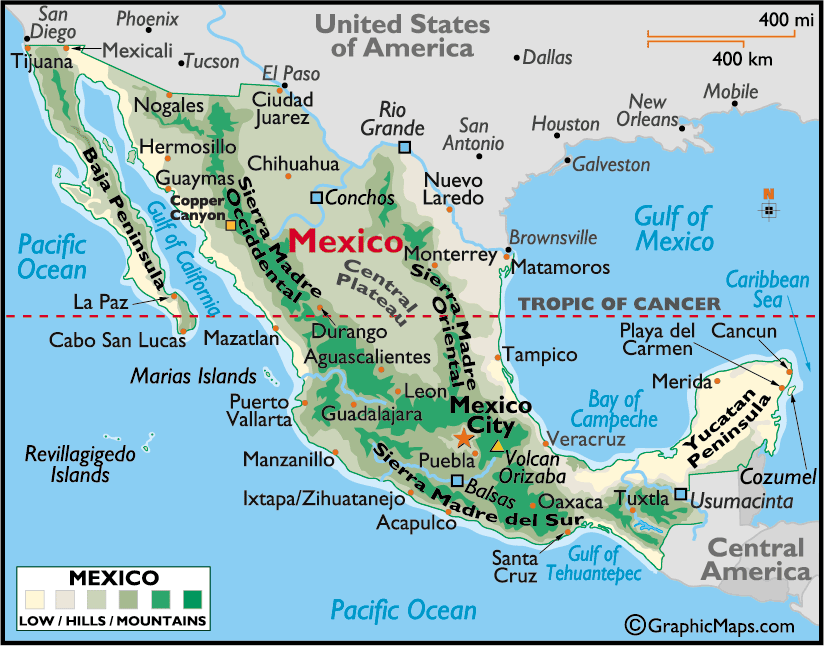
If you look at a map of Mexico it really doesn’t seem like we travelled that far in this vast country, the southern limit being Oaxaca and the northern limit Guadalajara, a distance of just under 1,000 kms. (600 miles). However, the variety of landscapes and terrain we encountered along the way was simply amazing. I had expected dry desert like scenes and we did get those in many places including some wondrous saguaro forests. I also expected and anticipated seeing the famous volcanoes Popocatépetl and Iztaccihuatl outside Puebla and we did see them although not as clearly as I hoped. This is snow capped Popocatépetl.
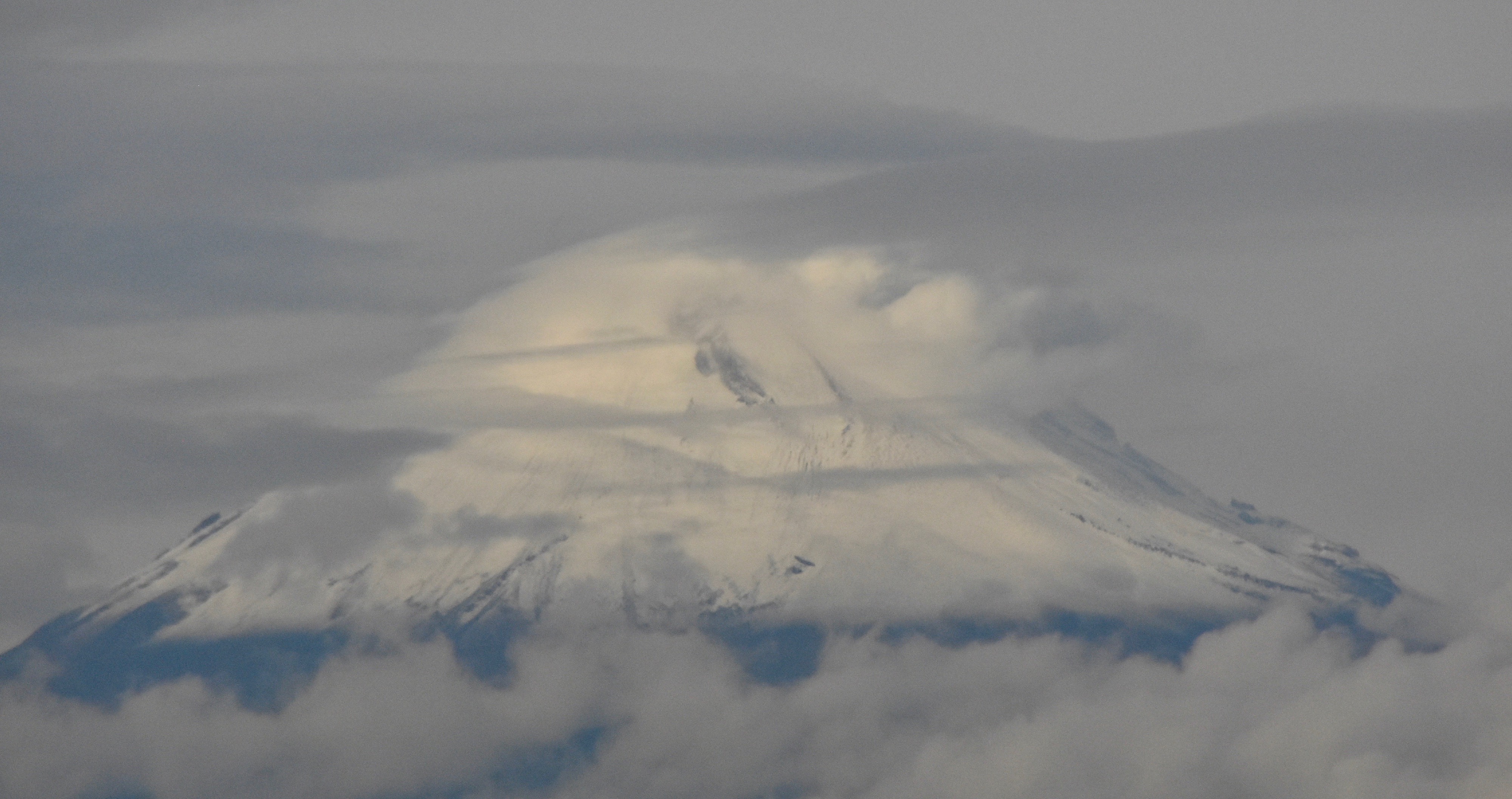
I also expected to see plenty of farmland and again, we did. These are corn stalk stukes, a method of storing cut corn I haven’t seen used in Canada for fifty years.
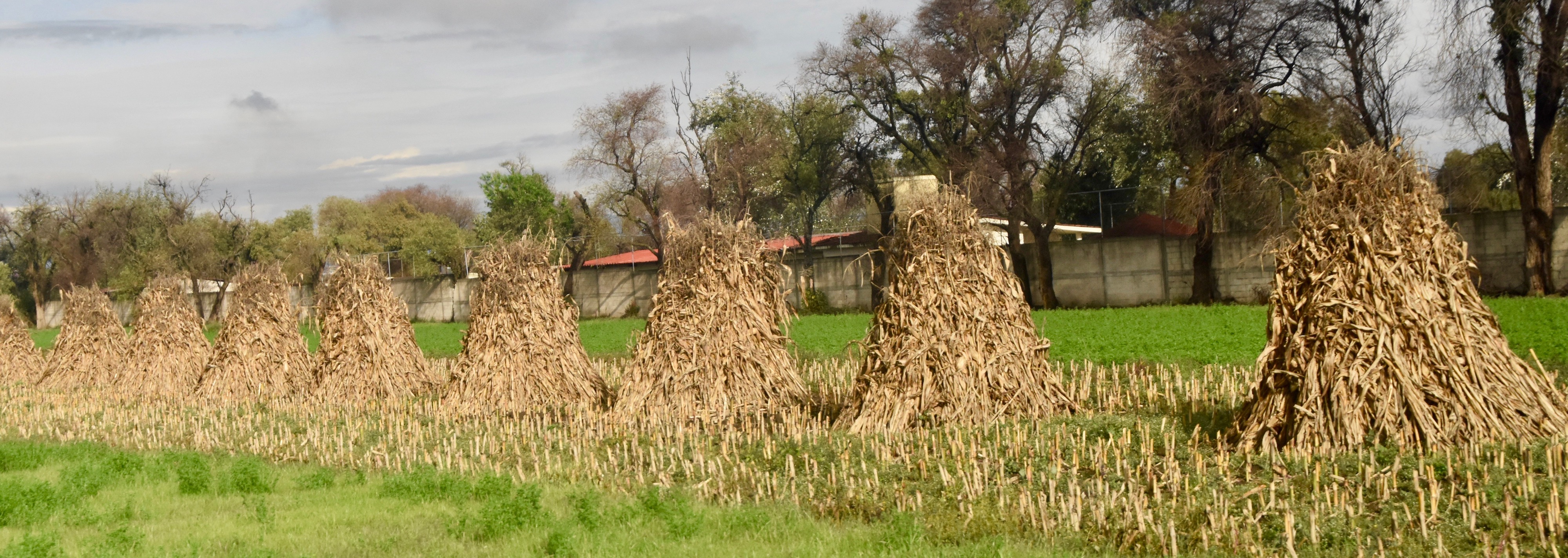
I did not expect to see fragrant scented pine forests, stands of hardwoods that a sawmill owner in Canada would die to cut down or huge mountain ringed lakes. Nor did I expect to see mile after mile of cultivated prickly pears, a plant we view as a bit of a nuisance in North America, but one vital to the very identity of Mexico.
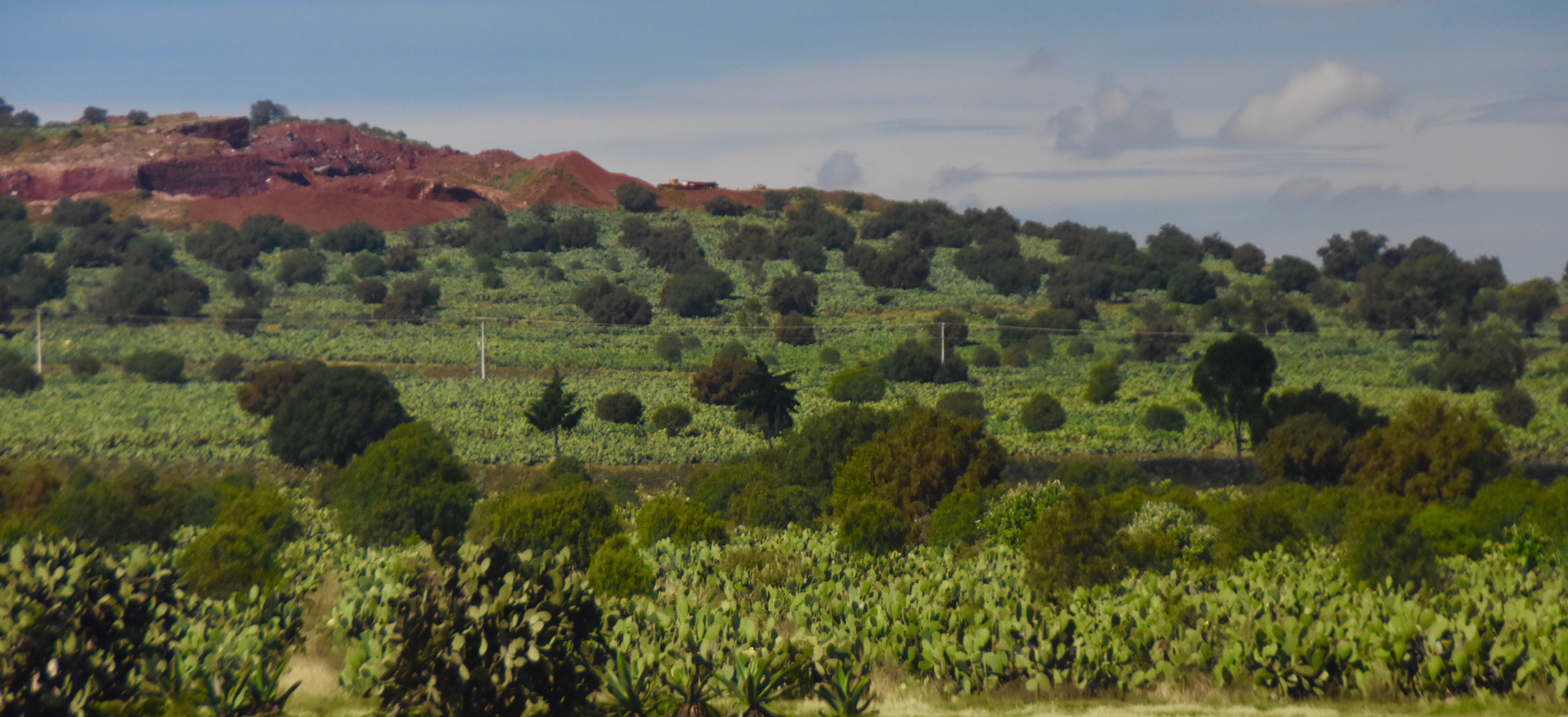
Every day that we travelled the from one city or town to another revealed something new and I was never bored looking out the window of the bus. By contrast, I drove approximately the same distance as we travelled in Mexico from Winnipeg to The Pas the town I grew up in Manitoba earlier this year and was bored as hell. Nothing but the same stunted boreal forest for hour after hour. I had feared Central Mexico might be the same and could not have been more wrong.
5. The Pre-Columbian History of Central Mexico

As a student of archaeology I have always wanted to visit the great pre-Columbian sites of Central Mexico, most notably Teotihuacan. Most people are aware of the Aztec and Mayan cultures that flourished in Mexico before the arrival of the Spanish, but in reality these were but two of many cultures that started with the ‘Mother Culture’ of the Olmecs around 1600 BC. Other civilizations included the Zapotecs of the Oaxaca area, the Toltecs, the builders of Teotihuacan, the Izapas and many others. In preparation for this trip Alison and I listened to a Great Courses lecture series by noted Professor Edwin Barnhart titled Maya to Aztec: Ancient Mesoamerica Revealed and we were very pleasantly surprised to find that the trip Victor had planned included almost every notable site that Professor Barnhart identified in Central Mexico. These included not only Teotihuacan, but also Tenochtitlan in Mexico City, the amazing hilltop city of Monte Alban overlooking Oaxaca, the Atlanteans of Tule, the murals of Cacaxtla, the unique friezes of Mitla and the gigantic buried pyramid of Cholula. In each place we visited Victor had arranged for a local guide to lead us through the site. Some were better than others, but they did add a level of understanding that you would not get by touring on your own.
In preparation for visiting these pre-Columbian sites the very first visit on the trip is to the fabulous National Museum of Anthropology where some of the most important pre-Columbian artifacts like the Aztec Sun Stone are found. If I can make one suggestion to enhance your enjoyment of this trip it is to go to Mexico City a day early just to have the time to really explore this museum as fully as you can. Read my post on the museum for more details.
The reality is that we would have been happy if this trip was just about the pre-Columbian sites and everything else a bonus.
6. The Colonial Era in Central Mexico
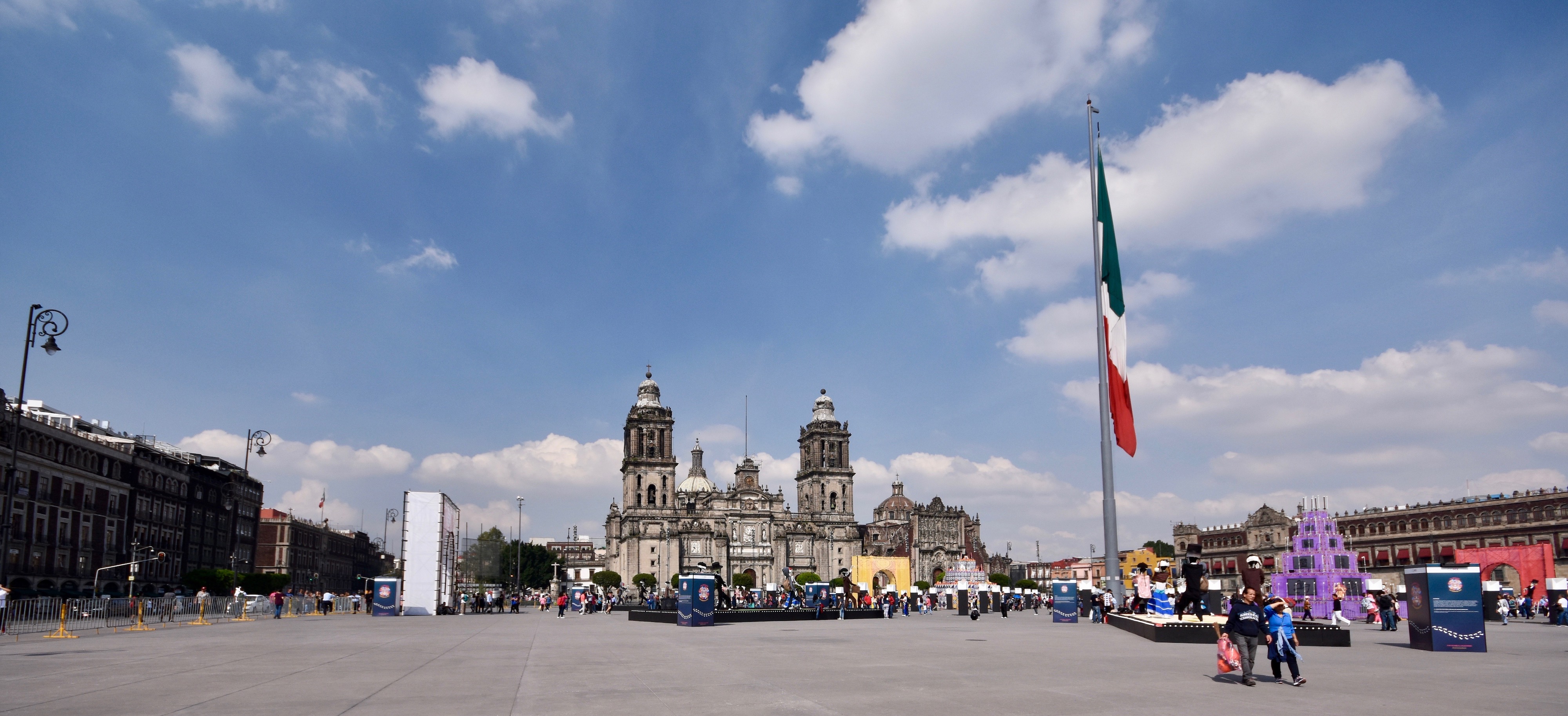
Mexico is famous for having some of the most historically important and beautiful colonial cities in Latin America and a surprising amount of them are in the Central Highlands starting of course with Mexico City and its grand cathedral on the Zocalo atop the ruins of Moctezuma’s Tenochtitlan. After leaving Mexico City there is simply one great city after another, all of which are completely different from each other. One area where I would put Mexico well ahead of Canada and the United States is in the amount of car free zones that you will find in these cities. As we arrived in each city Victor would usually lead a walking tour through these pedestrianized areas and give an overview of the city’s history, its unique culture and cuisine and the type of crafts the area was famous for.
While I was familiar by name with most of the cities we visited, others like Guanajuarto, home of Diego Rivera were not and came as complete and pleasant surprises. By my count we visited at least eleven UNESCO World Heritage Sites on this trip. Just like the visits to the pre-Columbian sites, the visits to the colonial cities of Central Mexico was like a tour within a tour that would have been worth doing just on its own.
7. The War of Independence in Central Mexico
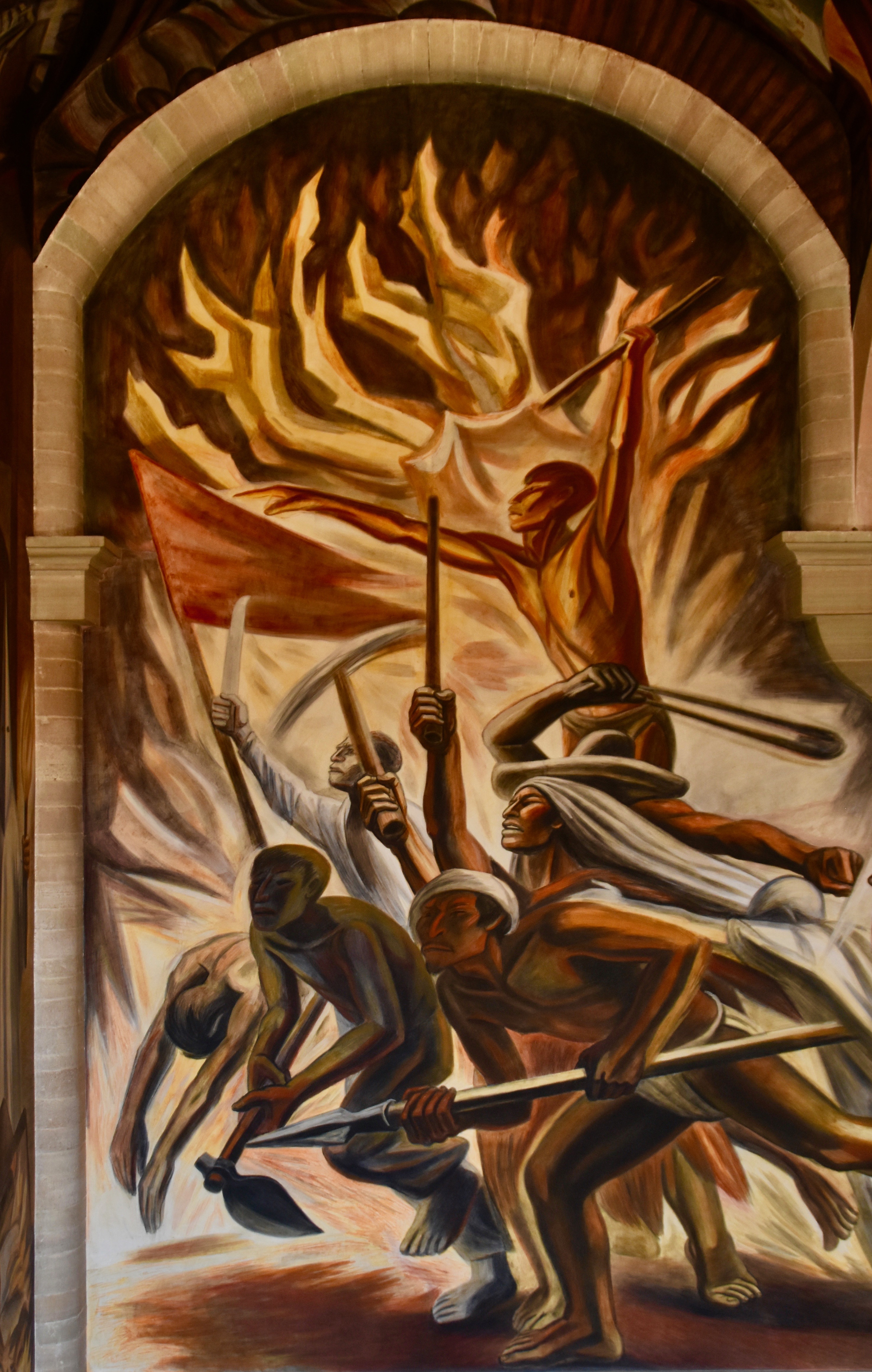
Everybody in the United States and Canada is familiar with the American War of Independence in which the colonial settlers threw off the yoke of British rule, achieving independence in 1783. However, few know many details about the longer and much bloodier struggle for Mexican independence that was fought from 1810 to 1821. Spain was a harder taskmaster on its colonies than Britain ever was, at least in North America. The decimation of the Aztec (more properly Mexica) empire and others by the Spanish conquistadores was perhaps unrivalled in its utter completeness in an amazingly short period of time. The Spanish maintained a strict class system that did not recognize the rights of the creoles, the name given to those born in Mexico of European descent. Only those born in Spain had rights in what was then known as New Spain. Below the creoles were a much larger group of mixed blood mestizos and below them, the Indigenous peoples.
By the late 18th century with the French and American Revolutions underway followed by the Napoleonic Wars that saw France take control of Spain and technically its overseas possessions, the desire for independence grew steadily in Mexico, particularly among the creoles. In 1810 outright rebellion broke out in the small city of Dolores led by a priest, Miguel Hidalgo and the rest is history.
Many of the major events of the Mexican War of Independence took place in and around the colonial cities visited on this tour including Guanajuarto, San Miguel Allende, Oaxaca and Puebla. Names like Hidalgo, Allende, Morelos and Guerrero were literally just names to me, until this tour. Victor did a great job of explaining the significance of each of these Mexican patriots and by the end of the tour I felt I knew enough about modern Mexican history to be able to interpret the many murals we encountered in public places throughout Central Mexico.
8. The Food & Accommodations
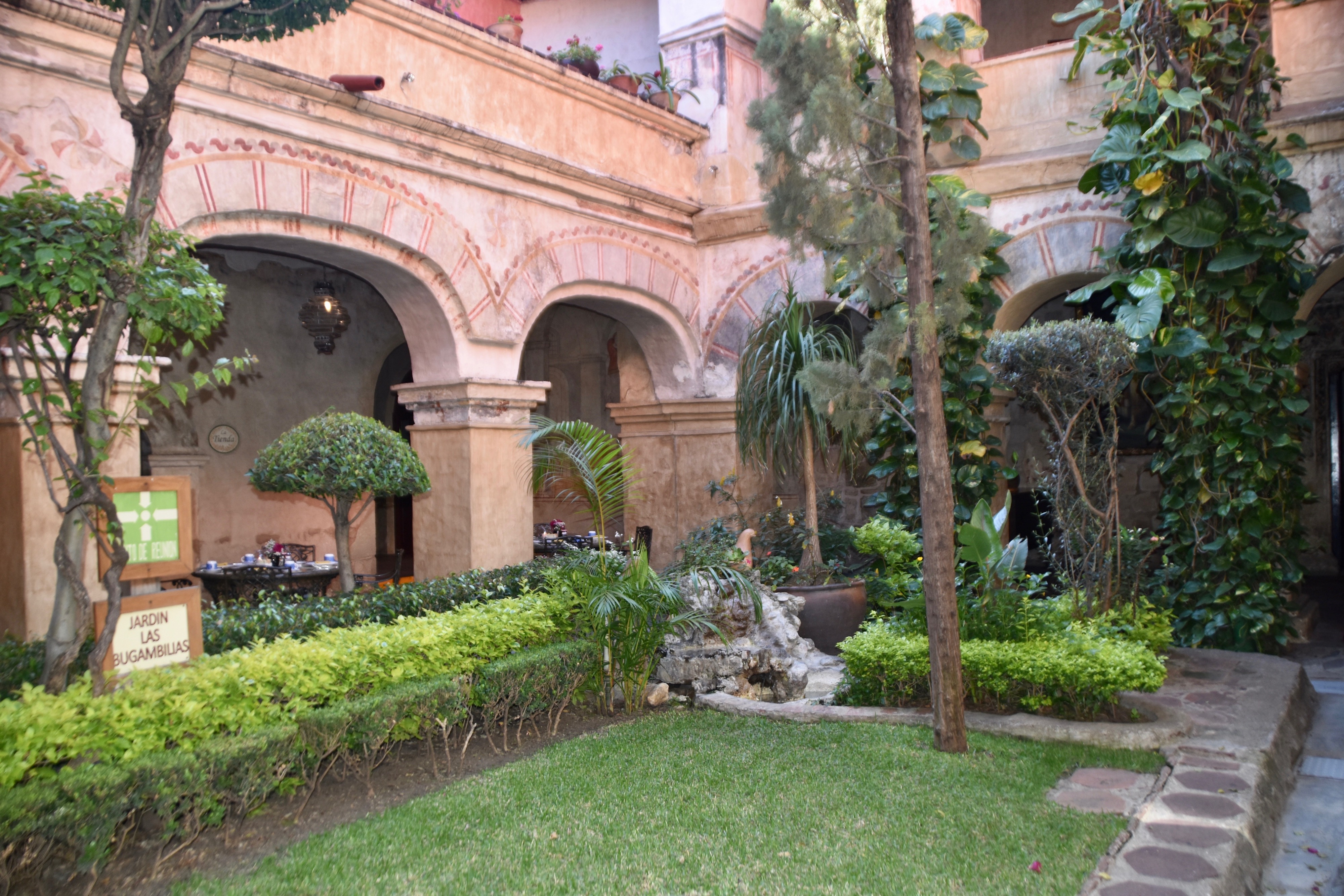
Adventures Abroad is not a super high end travel outfit as is reflected in their moderate pricing policy. However, in some countries you get a lot more bang for your buck than others and I really thought this was the case on this tour. While all of the accommodations were quite acceptable, a couple were really outstanding, especially the Quinta Real in Oaxaca where we spent four nights during the height of the Day of the Dead festivities. Located in an old convent it was quite simply luxurious in all respects. The breakfast buffet was the best on the tour with a great mixture of Mexican breakfast items and what Americans and Canadians would view as traditional buffet fare.
I did not expect to be staying in a hotel of this caliber, especially at what is the busiest time of the year.
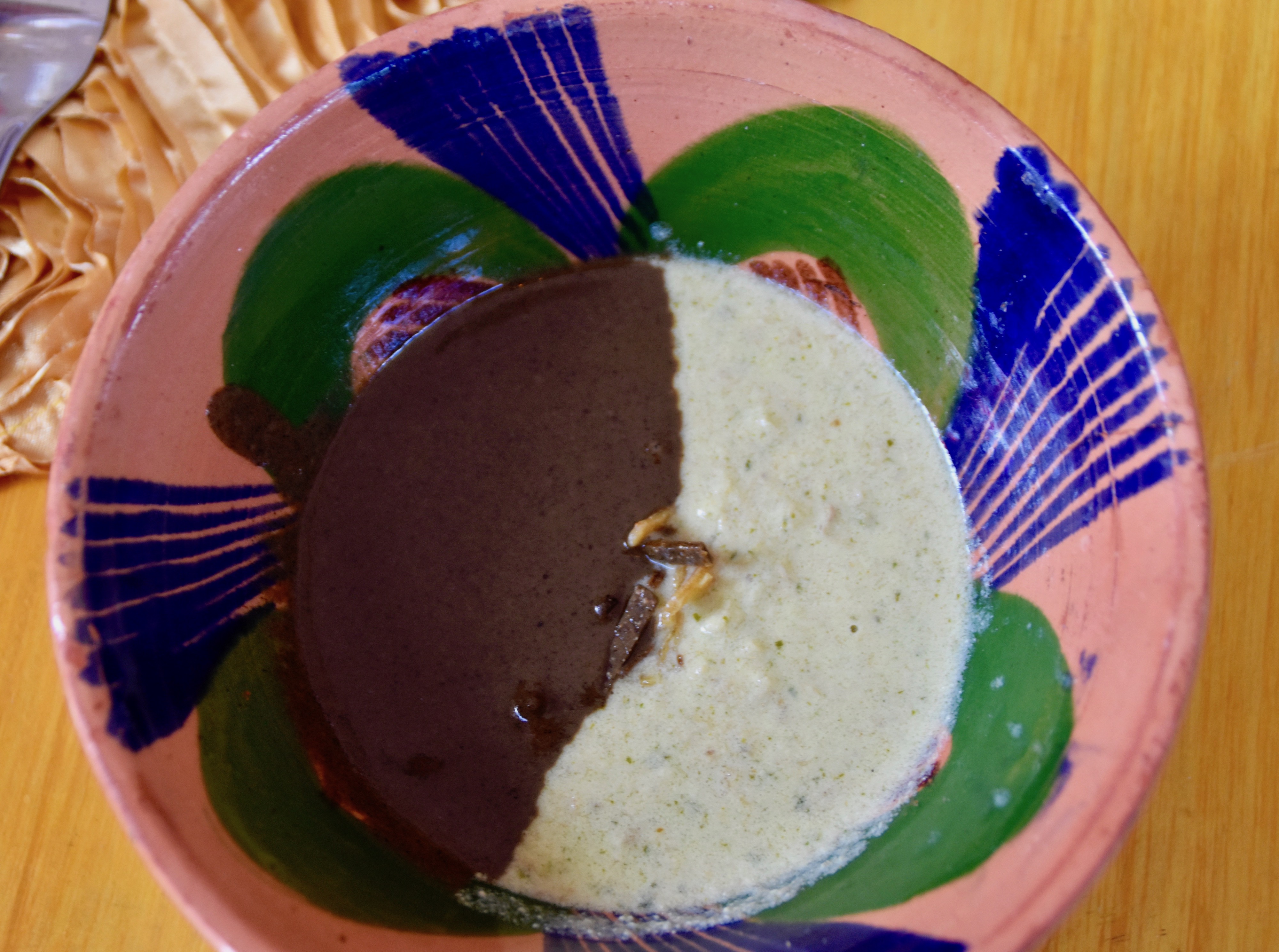
As far as the food went on this trip I have covered most of it in reason two, but this was really a trip where you could eat as adventurously or as conservatively as you pleased. The Mexican diet is completely different than that of Canada or the United States with far less meat and more vegetable based dishes, especially beans and corn. That being said, you could get a good steak or even farmed salmon if that is your thing. My preference was to stick to Mexican dishes and I believe I lost about five or ten pounds on this trip which was a nice side effect. You don’t get fat eating grasshoppers.
The bottom line is that the cuisine on the Central Mexico tour is a highlight and not an afterthought.
9. The Day of the Dead
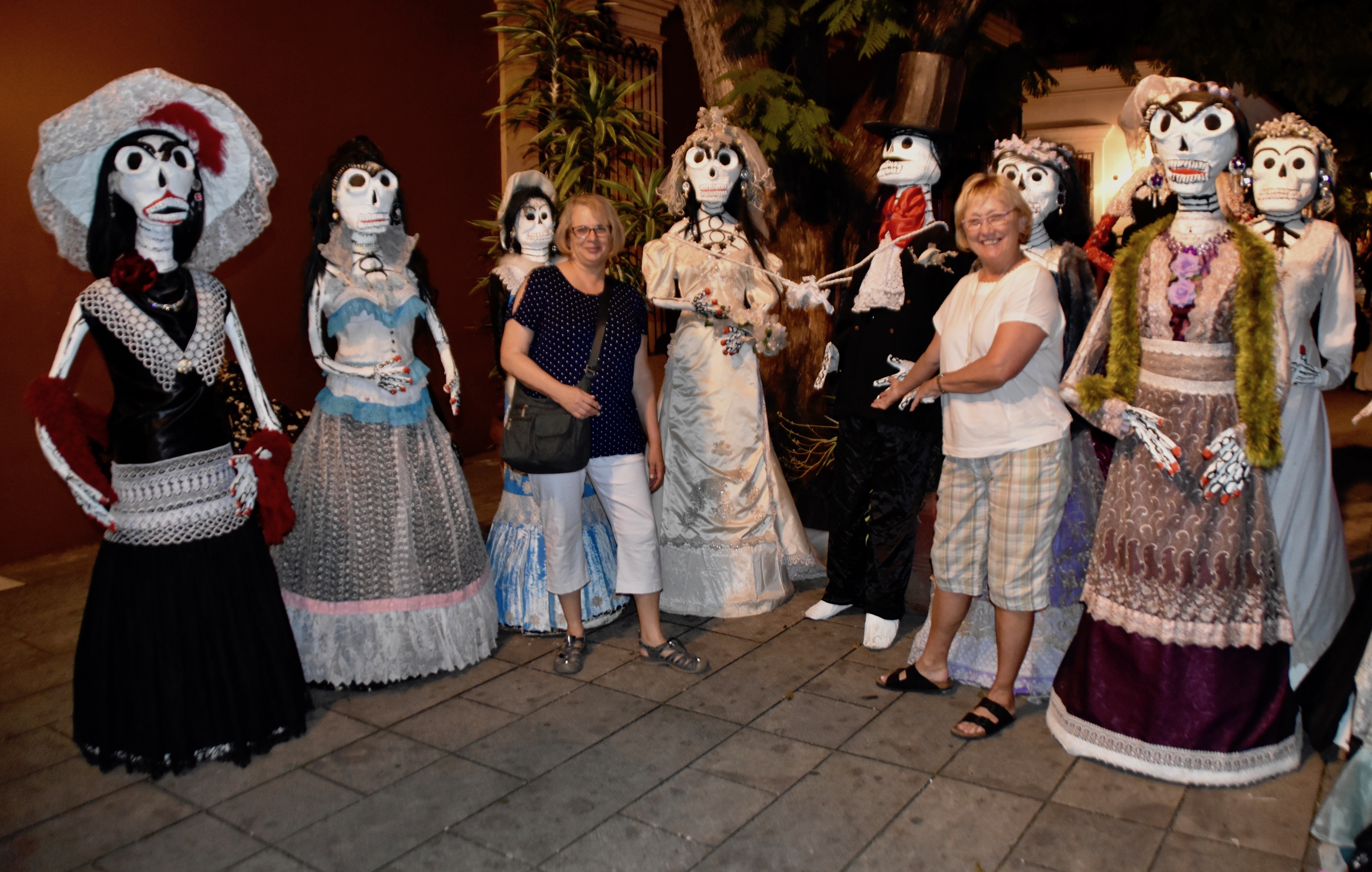
I come now to the number one reason Alison and I signed up for this trip – to see the Day of the Dead ceremonies. I have long been fascinated by this combination of pre-Christian and Catholic customs that has been woven together into what is really a celebration of life by banishing the fear of death. Until coming on this tour I naively believed that the Day of the Dead was just that, one day like Christmas or Halloween in which people dressed up as skeletons and danced around.
In fact the Day of the Dead lasted in one form or another the entire time we were in Mexico and has many distinct parts. One is the cult of the Katerinas who were Mexican women of Spanish descent who returned to Spain to have their children so they could have the rights of Spanish citizenry. They were sort of the first uber bitches. These days in Mexico they are in effect mocked by being dressed up in finery, but also are dead. The Katerinas were everywhere we went and some where really outstanding works of art.
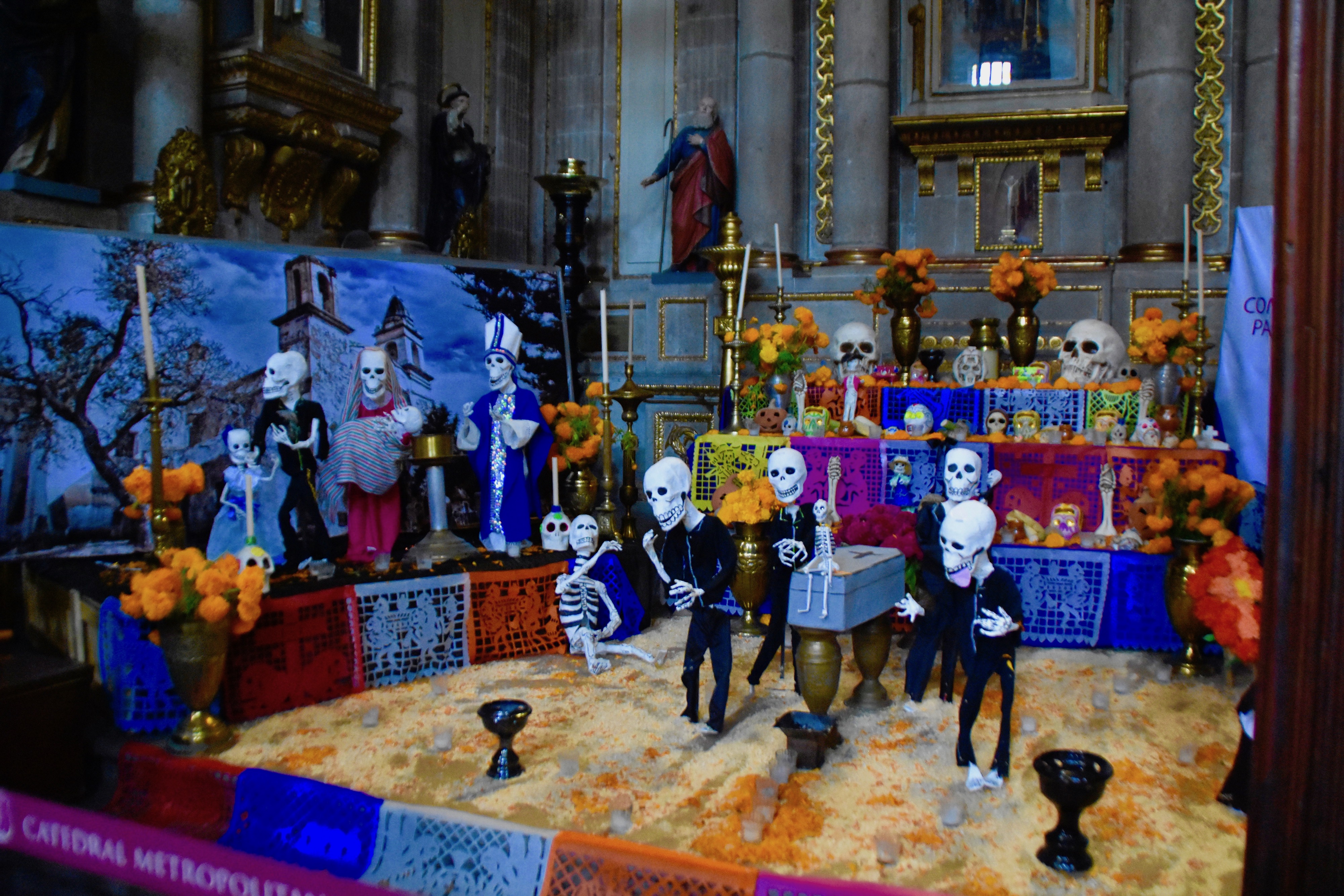
Another part of the Day of the Dead ceremonies is the creation of altars to the dead. Every business, institution and most private homes create these altars and leave them up for weeks. This is the one at the Metropolitan Cathedral on the Zocalo in Mexico City. You really don’t expect something like this to be created by Catholic priests, let alone condoned.
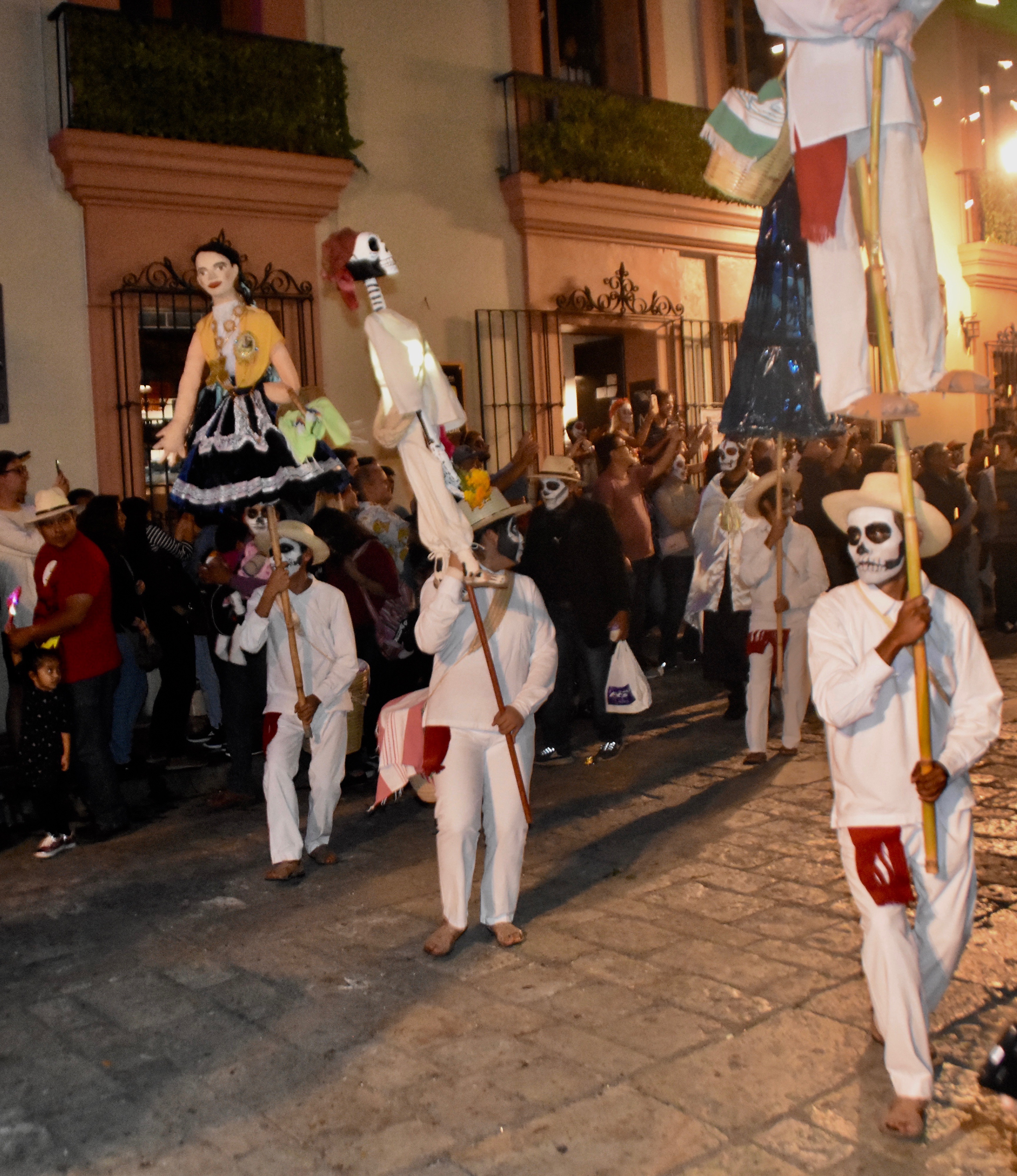
Then there are the parades and dances and music. It’s almost like half of Mexico is participating in one way or another and the other half is watching. These really are worth travelling to see.
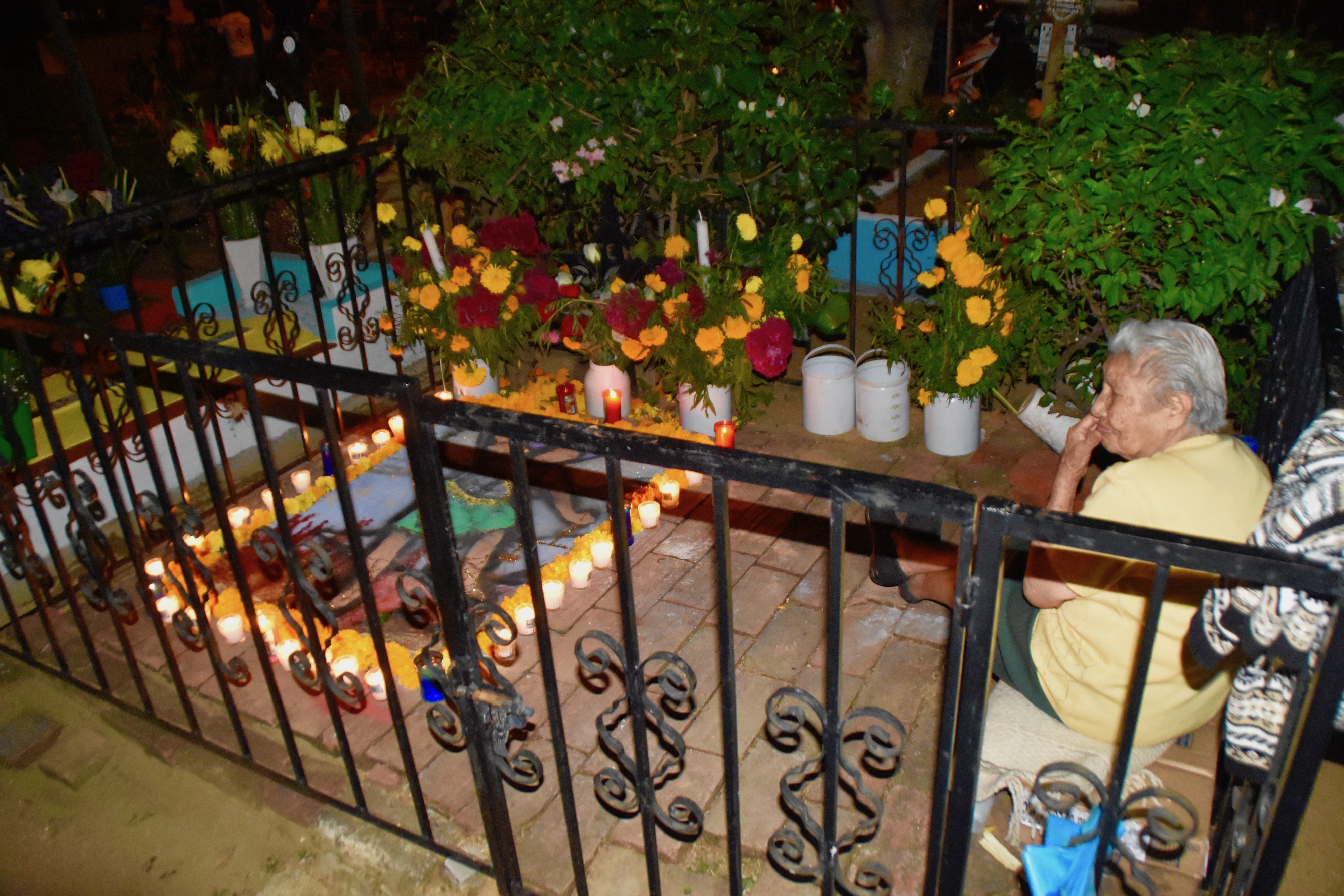
Lastly, there are vigils at the cemeteries that take place over two days, one of which coincides with Halloween, but is actually completely different. This woman is communing with her dead husband who she believes will return to visit from the grave on this night. All over Central Mexico the cemeteries come alive, no pun intended, with colour as almost every grave is festooned with flowers, candles, food, drink and often photographs of the deceased person. This is not a sad, but a joyous night and you won’t find people crying or in obvious mourning as you might expect. I have to confess that I did feel a bit like a voyeur during the visits we made to two cemeteries, but the Mexicans did not seem to mind and several spoke to us about the loved ones they were waiting to return.
The Day of the Dead portion of the trip far exceeded any expectations I had about what I would see and once again could have been a complete tour on its own. The vast majority of spectators at the Day of the Dead ceremonies were not tourists, but locals, However, I fear that with time the number of tourists may grow to the point that they inundate cities like Oaxaca, driving up prices and lessening what is truly a spectacular thing to witness. So go now!
I will be writing detailed posts on each aspect of this tour in the coming months. I hope you will stay tuned.

